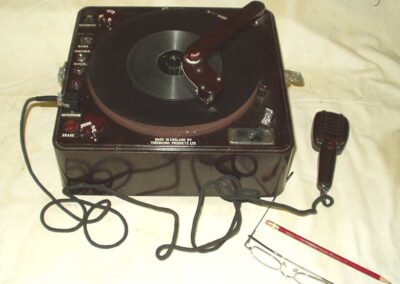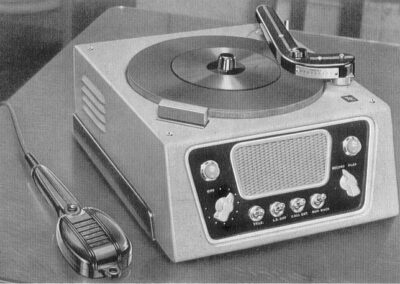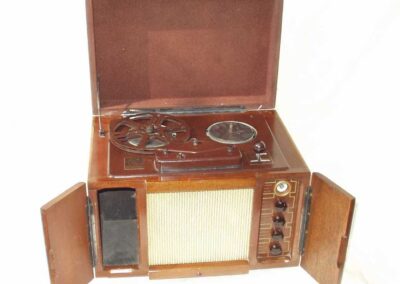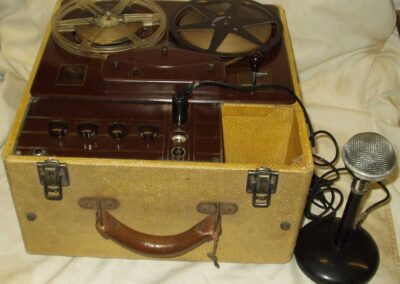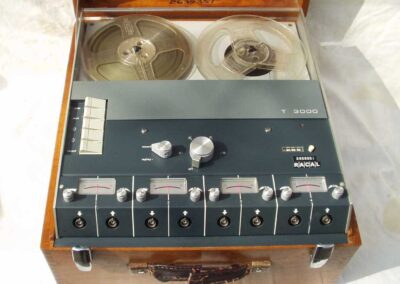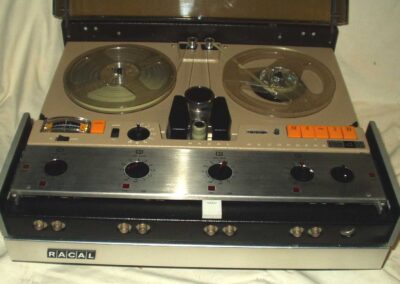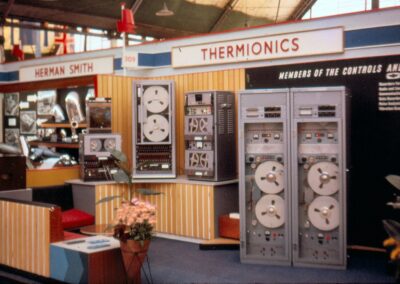The stories of the Brush Development Company, Thermionic Products, Racal-Thermionics and Racal-Recorders are told in “A Truvox Product” – as will soon become clear!
Founded in 1944 by Alfred Colley and Edward Angold, both had experience of piezo-electric devices and work on secret war-time communications equipment. Their work drew them to that being carried out by the American leaders in crystal and piezo-electric technology, the Brush Development Company. Following an exploratory visit to Brush in 1946, Angold became enamoured with America’s new electronic flash-guns while Colley saw a commercial opportunity in Brush’s magnetic recorders, developed by Semi Joseph Begun.
Thermionic Products’ first product was Britain’s first electronic flash-gun, the ‘Mega-Flash’, but while they also developed patents on cinematographic sound recording, their future lay in magnetic recording. Having secured rights to an improved Brush “Mail-a-Voice” disc recorder of 1946, they launched their “Recordon TP503″ in spring 1948 using a B&Y fan motor, built by their subsidiary company. This was marketed as an office dictating machine and operated very much like a gramophone, recording onto a 9” magnetic oxide coated paper disc which could be folded into three and posted to another office, making it especially popular with travelling salesmen.
The Recordon’s success allowed the company to take up offices in Jermyn Street, London. It was later produced at their new Hythe works, as an improved TP504, along with a deluxe ‘Diplomat’ version in 1953 which incorporated an intercom with the secretary and telephone amplifier. The Recordon survived into the mid-1950s when they took up assembly of the Swedish ‘Agavox’ recorder.
Thermionic Products duly secured the licence to build the Brush BK.411 ‘Soundmirror’. This entered production in late-1948, albeit being contract assembled by the Walter Instrument Company. This was the first British-built domestic tape-recorder as the British designed and built Wright & Weaire tape-deck did not enter production until several months later. However, problems soon became apparent with the quality of the oxide-coated paper tape, made for them by the ‘Butterfly’ label business, as the oxide shedded far too readily, and clogged the heads! While this was being sorted out, Colley made a fortune producing the drinking-duck novelty solar toys!
Promoting the new-fangled Soundmirror was problematic. While the 9″ disc Recordon had opened up the office dictation market, the Soundmirror, with its ‘Magic ribbon’ tape, was aimed at longer duration recording of lectures, meetings, concerts and in the home to record memorable events, but it was a slow seller as Britain was still suffering rationing. Never-the-less, the design was soon licensed to European companies such as Carad, Tandberg and even Studer.
The Soundmirror TP.411 was a single speed (7-1/2ips) machine and one of the first to use a swinging arm pinch wheel operation. It employed a cross-over belt drive with joy-stick control and ‘pop-up’ permanent magnet erase head. The ‘full track’ head used only the central 2/3rds of the tape. Unlike today’s 3-wing DIN drive, the spools were driven by upturned flanges on the spool turntable, later superseded by offset pin to engage DIN centre spools. It sold at £69 in a superbly made walnut veneered cabinet as a piece of domestic furniture, complete with large stick microphone and internal speaker.
Production moved to Hythe, Hampshire in 1950 and soon faced its first major British competitor, the well built Baird ‘Soundmaster’. The table top Soundmirror was joined in 1951 by the ‘Portable’ TP.414, in a wooden suitcase, finished in a yellow/brown fabric, which had provision for extra spools of tape, a large ACOS microphone and cables: it was surprisingly light! It sold for £79. There was talk of a new 2-speed on-demand version, possibly the new Brush BK.455, but those from Thermionic Products were 1/2 track versions of the old Soundmirror in a slightly modified cabinet with what appears to be optional factory-set 3-3/4 or 7-1/2ips – (can anyone confirm?). Production of the Soundmirror continued to late 1954.
Multi-channel recorders
A new post-war Convention on International Civil Aviation brought forth statutory demand from 1951 for the logging of all Air Traffic Control to pilot communications. This required multi-track machines, but while the Royal Aircraft Establishent and Simon developed a indented recording (like a record) on 35mm film stock, Brush and Thermionic Products developed multi-channel magnetic tape voice loggers with the first all-British airfield recorder being developed independently by Thermionic Products in London in 1949, launched in spring 1950, after which Brush pulled out of further magnetic tape development to concentrate on their core crystal business, much to Begun’s dismay.
The 14-channels were recorded on 0.7″ wide paper-tape, initially using interlaced 7-channel heads, in pairs of coupled decks allowing continuous 24-hour recording, plus a replay deck. The improved, slower running Series II (1-7/8ips) appeared in 1953 and soon Thermionic Products were dominating the market: their decks even recorded the fatal DH Comet crashes in Italy.
After George Colley died in 1956, the company became a subsidiary of the expanding Pena Group in 1957, joining Cosmocord and Peto-Scott. They were now pinning their hopes on a major contract for recorders for London Heathrow airport, but it went to the British Communications Corporation – a young company owned by Daniel Dan Prenn of Truvox fame. The failure to win the contract soon pushed Thermionic Products and Pena into financial difficulties at which Prenn bought Thermionic Products in late-1958 and production of airfield voice-loggers continued at Hythe under a new company, Thermionic Products (Electronics) Ltd leaving BCC to concentrate on their core military and police radio communications.
Audio Division
Colley was always keen to diversify and in 1952 the company offered a range of (unknown) ‘instruments for electro-acoustic measurements’ and ‘Acousticel’ microphones. In 1955 he gained world-wide distribution rights to the new Kelly electrostatic loudspeakers. Then from 1956 Thermionic Products added their highly regarded TP100 audio amplifier and the ‘Microlift’ gramophone tone arm lifter, later licensed to Decca.
Thermionic Products (Electronics) Ltd
Thermionic Products would remained world leaders in multi-track recorders and with expertise gained through Epsylon and Vectron engineers, expanded into instrumentation recorders and digital technology.
In 1967, Daniel Dan Prenn transferred his ‘Truvox’ audio business to his Thermionic Products operations; Truvox’s audio and floor cleaner production moved to Hythe but the Truvox Floorcare business soon reverted to the Prenn family.
Thermionic Products’ expertise in military contracts soon transformed the quality of Truvox’s domestic tape-recorders; indeed the Truvox Series 100 was chosen as the basis for their first portable instrumentation and seismic recorder, the T3000. This now had four speed operation and advanced electronic pcb circuitry. It was superseded by a modified Truvox Series 200 deck and alone survived as the Racal-Thermionic T3000 when Thermionic Products and Racal merged in 1969 following both Racal and Thermionic Products’ interest in the ‘Clansman’ military back-pack radio contract.
In addition to their multi-channel communication recorders, Racal-Thermionic developed an incredibly versatile and truly advanced portable instrumentation recorder, the Store 4, which replaced the T3000. This offered optional speed ranges from 15/640ips (for seismic work) to 60ips in 4-, 7- and 14-channel formats, the latter often used in industrial production control processes. Highly regarded for its delicate and accurate tape transport, it was the machine of choice for replaying fragile aircraft “Black-box” tapes for crash analysis.
In 1971 Racal bought the Zonal (formerly llford-Zonal) magnetic tape business but sold it in the 1980s; Zonal are still in business. By 1977 the company had become Racal-Recorders and further developed specialist communications and instrumentation recorders, but these are beyond the scope of this audio web-site, although are covered in the book.
Subsidiaries
Among the many companies who came under Daniel Dan Prenn’s wing were: Airmec, British Communications Corporation, Celestion, Modern Aerials, Racal, Truvox, and Vectron. Their stories are also recorded in “A Truvox Product”.

